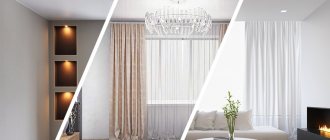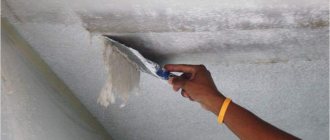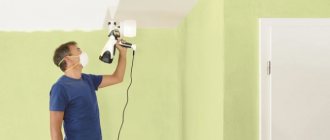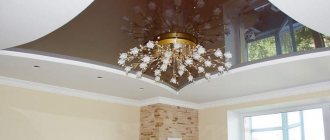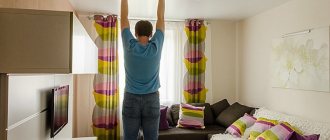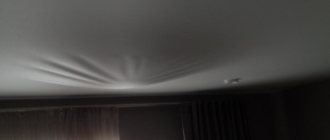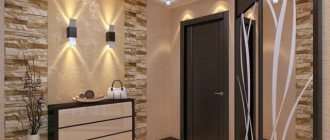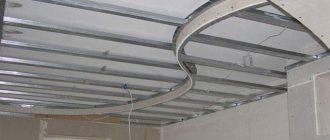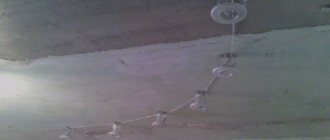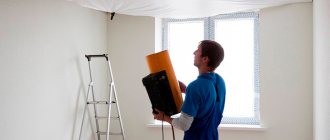The development of the construction industry has turned the problem of finishing the ceiling space from a simple task into a complex puzzle. If earlier you just had to choose between painting the ceiling with water-based paint or wallpapering, today you need to decide between a suspended and suspended ceiling - the most popular options among the population, and in the latter case, also between glossy, matte and satin panels.
In order to better understand the problem, to understand which ceiling is better - suspended or suspended, we will conduct a comparative analysis of these types of ceiling finishes according to all possible parameters.
Common features of stretch and suspended ceilings
The main advantage of tension and suspension systems is their attractive appearance and variety of design options.
Also, these ceiling coverings have the following advantages:
- Excellent sound insulation properties.
- Possibility of additional insulation of the room.
- No complicated work to level the ceiling.
- Masking of communications and cables that are present in the room.
- Creating comfort in the room.
- Possibility of hiding any defects: cracks, panel joints, chips.
Why this particular finishing option?
Many apartment owners who have installed one of the types of ceilings under consideration say about their choice simply: beautiful. However, this answer does not explain the enormous popularity of new types of ceiling design among homeowners.
In fact, this finishing method allows:
- hide all ceiling flaws: cracks, chips, panel joints, slope, etc.;
- do not carry out labor-intensive and dirty work to level the ceiling surface;
- hide communications (various cables) running on top of the apartment;
- increase the level of noise insulation;
- additionally insulate the room;
- create more comfortable living conditions;
- bring to life the most fantastic ideas of designers.
Stretch ceiling - main differences from suspended ceiling
First you need to determine what differences exist in the design of tension and suspension systems. The main difference is different fastening systems. The tension fabric is attached to baguettes, which are fixed along the perimeter of the walls; fabric or polyvinyl chloride film is stretched between them (that’s why they are called tension).
The suspended ceiling is mounted to a rigid suspended frame, which is secured not only to the walls, but also connected to the ceiling.
The difference between a suspended ceiling and a suspended ceiling is as follows:
- Suspended ceilings are more resistant to mechanical damage. The plasterboard with which the frame is sheathed is not afraid of impacts and contacts with sharp objects. The film or fabric base of a stretch ceiling is a delicate fabric. They can be damaged very easily by a small blow or scratching with a sharp object.
- Repairing a suspended structure is an easier procedure. If desired, you can replace any element. If serious damage occurs to the stretch ceiling, the canvas will need to be replaced.
- The suspended structure has a more rigid and durable surface. A suspended ceiling can sag under the influence of certain factors, for example, when flooded by neighbors from the upper floors.
How to make the right choice
There is no point in comparing completely different systems aimed at completely different goals. If the customer requires a simple, even if not the cheapest, ceiling decor that is easy to maintain, easy to repair, and will not interfere with further installation of communications along the ceiling, then it is best to choose a suspended ceiling. This type of finishing is widely used as a universal solution in rooms and offices where it is vital to maintain a certain level of microclimate.
Film fabric ceilings are well suited to cafes, bars, hotels and the foyers of entertainment establishments, where the decorative part plays the most significant role.
In addition, the market, like the technology for manufacturing fabrics and membranes, is constantly developing and improving. Today it is possible to select materials that can combat noise, and at the same time have a high level of transmission of water vapor and air. Sufficient so that the atmosphere of a greenhouse does not appear in the room. Such models are more expensive than conventional fabrics, but they are available on the market, so future owners have a choice - to use traditional panel ceilings or invest in the most modern, super beautiful and environmentally friendly stretch fabrics.
Which option is better to choose?
Which ceiling to choose: suspended or suspended? Many owners ask this question. Advantages and disadvantages can be identified by comparing the characteristics of these systems.
The suspension system has a complex design; markings on the surface are quite difficult. To work, you will need a partner (or several assistants). For installation you will need a basic set of tools: a screwdriver and a hammer drill.
It is not so difficult to stretch polyvinyl chloride film or fabric onto baguettes, but such work can only be entrusted to a good specialist. The reason is the high probability of damage to the canvas, and it is expensive.
Installation of the tension structure will take 1 day. It will take 2-4 days to install the hanging system. When installing a complex multi-level structure, installation of a tension system can take 2 days, and installation of a suspended ceiling with a complex structure can take as long as 10 days.
Differences
A hanging solution assumes the presence of a rigid base to which fragments of the external decorative coating will be attached. Textile or PVC fabric is attached only to baguettes installed on the wall, unless installation of several levels is intended.
Installation times for different types of tracks will vary greatly. If textiles and PVC film are installed in a few hours, then the hanging system may require up to several days of work. The installation time of a suspended structure directly depends on the type of external covering. If it is drywall, the finishing work may take even a week.
The cost of these types of finishes also differs. In the vast majority of cases, stretching the canvas is significantly cheaper, unless the most expensive material is chosen or you do not plan to create many levels. A suspended solution can cost only slightly less than a tension one if cheap plastic panels are chosen as the exterior finishing. However, in this case, the composition will not look very attractive.
The suspended system can be installed with your own hands, without the use of complex tools or special knowledge. With membrane coatings everything is much more complicated. Without special tools, only textile types of fabric can be mounted. PVC films are stretched using a special heat gun, which not everyone has.
A hanging solution will not save you from flooding by neighbors, while PVC will perfectly retain all leaked water. In addition, after draining the accumulated water, the film can simply be re-stretched, but drywall will not tolerate contact with water - it will have to be partially or completely replaced.
Designers' options in the case of rigid solutions are significantly limited, especially when it comes to panels. There is no such problem with film or textiles - a variety of textures and colors will allow you to choose an option for any interior or create a completely unique composition.
The option with gypsum plasterboard or panels makes it possible to partially replace or repair the damaged area. This will no longer be possible with a stretched canvas - if it is damaged, in most cases you will have to make a complete replacement, which practically means a new repair. In rare cases, local repair of the damage may be sufficient.
If a textile version of the canvas is installed, it can, if desired, be repainted; however, films cannot be painted. The situation is similar with frame solutions - except for drywall, no surfaces can be repainted.
Lifetime
One of the most important factors when choosing is durability. Manufacturers of PVC sheets determine the service life of products - more than 20 years (with proper care).
However, not everything is so simple here. Much depends on the cost and quality of the material. Durable and expensive PVC film can last the specified period. Materials in the mid-price category may lose their attractive appearance after 7-9 years of service. Such coating will have to be replaced 12-15 years after installation.
Suspended systems can last 20-30 years, but there is another nuance. They should be repainted every 6-8 years. It’s hard to say which is preferable – simple maintenance over a long period of time or regular updates with a long service life. The choice depends only on the personal preferences of the owner.
Comparative analysis
What to install in an apartment - a suspended or suspended ceiling - the pros and cons of the decision can be found out only by comparing the main characteristics of the systems being compared.
Degree of installation complexity
When comparing the complexity of the work performed to install both types of ceilings, a paradoxical situation arises: the structure of the frame of the suspended ceiling is complex, there are difficulties in applying markings to the surface of the ceiling space, but the work can be done independently, although only with a team (at least 2 people) having basic skills in working with power tools (hammer and screwdriver). It is easier to stretch PVC or polyester film onto baguettes, but the work cannot be entrusted to a non-professional - there is a high risk of damage to the fabric.
Speed of work completion
A suspended ceiling is installed within 1 working day, while a suspended ceiling requires 2 to 4 days. If the design becomes more complex (increasing the number of levels), installation of a stretch ceiling can take up to 2 days, while a suspended ceiling can take 10 days.
Cleanliness in the apartment during installation
All publications claim that when installing a stretch ceiling there is very little dirt, and when installing a suspended ceiling there is a lot. From this it is concluded that in this regard, the tension structure has a huge advantage. Is it so?
Indeed, if we compare the weight of dust and dirt generated when working with plasterboard and suspended ceilings, the comparison is in favor of the latter. But the conclusions drawn from this are not entirely correct.
Regardless of the amount of dust, glued walls must be covered with plastic film in both cases - dust from drilling holes in the wall from the trellis sheet is difficult, and often impossible, to remove.
It is also necessary to remove all furniture from the room both when installing a suspended ceiling and when stretching the film. If you cover it with polyethylene, the smallest particles of dust will still settle on the furniture, no matter in what ways. Will have to clean it. It’s just that in one case there will be a large layer, in the second – a small one. Therefore, in our opinion, there is equality here.
Durability
An important criterion when choosing the type of ceiling is its service life. Manufacturers of PVC film indicate in their recommendations that the canvas, with proper care, can last more than 2 decades.
It's not that simple here. Indeed, a thicker and, therefore, more expensive film is capable, with a slight loss of aesthetic qualities, to serve the specified period. Materials of the average price category, which are widely used, after 8-9 years of operation begin to lose their original appearance. Such a ceiling has to be replaced approximately 14-16 years after installation.
GCR does not have a service life specified by the manufacturer - such ceilings can last 20-30 years. But here is another problem. They need to be repainted every 7-8 years. It’s hard to say which is better – trouble-free maintenance over a long period of time or periodic surface renewal, but with a very long service life. Here the choice is at the discretion of the customer.
Strength
The strength indicator is one of the few parameters where one of the ceiling systems has a decisive advantage. Stretch ceilings are very sensitive to any mechanical stress - they tear, unlike gypsum board, which can withstand significant mechanical loads.
Care
Caring for the suspended structure and the stretched fabric is equally simple. It is enough to do wet cleaning a couple of times a year. It is advisable not to remove difficult stains on the film yourself - you may end up with stains that are difficult to remove.
There are specialized cleaning companies for such work. In the end, stubborn stains on gypsum plasterboard can simply be painted over. Here it is also difficult to give preference to one of the ceiling finishing systems.
Moisture resistance
A suspended structure made of gypsum plasterboard is resistant to moisture (water and steam); stretched PVC film can be installed in any damp room (kitchen, bathroom). Almost all observers point to another advantage of the film ceiling - its ability to retain water when it flows from above (it can easily withstand up to 100 liters).
However, they overlook the fact that water can cause a short circuit in the electrical wiring of the lighting system. In this case, burning wires cannot be extinguished with water - there is a risk of an apartment fire. What is more important in this case - protecting the apartment from flooding or the risk of fire - is difficult to say.
Loss of room height
Both options “steal” at least 5 cm from the room. Many publications indicate that the frame lowers the ceiling by 10-20 cm, but does not explain why this happens. In fact, if we add up the thickness of the plasterboard, the height of the ceiling profile (CS) and the minimum length of the suspension, we get the same 5 cm as for a stretch ceiling.
It’s the same with a suspended ceiling - they indicate a minimum distance of 3.5 cm in the height of the baguette, but do not say how to work with a hammer drill or electric drill when drilling holes for dowels - due to the size of the cartridge, the baguette will be installed 1.5 cm lower than planned.
Fire resistance
Both materials, PVC and plasterboard, do not support open combustion, but when exposed to high temperatures, PVC releases harmful toxins, unlike gypsum, which is absolutely safe.
Aesthetic perception
Stretch ceilings have more possibilities for various interior design solutions. The surface of the stretched fabric can be:
- glossy;
- semi-gloss;
- matte;
- under velvet;
- under the skin, etc.
The colors reach 100 different colors. Various drawings can be applied to the surface, up to a photograph of the owner of the apartment, etc. The designer’s imagination is practically not limited to such a ceiling.
With a suspended ceiling, the options for implementing design ideas are a little more modest. Here you can experiment with ceiling levels, surface color and lighting. Such ceilings look just as impressive.
It is difficult to give preference to any system. Everything is determined by individual taste.
Which is cheaper?
When determining which is cheaper, suspended or suspended ceilings, the authors of numerous articles on the Internet draw conclusions that are not entirely correct. For some reason, they only compare the price of 1 m2 of plasterboard and PVC sheet.
Based on the cost of the material, it is argued that without taking into account the work, plasterboard ceilings are approximately 2 times cheaper than stretch ceilings (100-120 rubles versus 200-250 rubles). But they miss one very important point: the cost of the frame, materials for finishing, including paint, calculated per 1 m2, is 5 times more than the cost of plasterboard.
In total, it turns out that for 1 m2 of suspended structure you need to spend 600-700 rubles from the family budget. If you hire a professional team, the price will skyrocket to 2500-3000 rubles/m2 (it includes not only the work of assembling the frame and covering it with plasterboard, but also sealing seams, putty, surface treatment with a primer and painting with water-based paint).
The price for 1 m2 of stretch ceiling ranges from 700 rubles/m2 to 2,000 rubles/m2. When using exclusive fabric, the cost of 1 m2 can reach 7,000 rubles.
If we compare materials of the average price category and work, then a suspended ceiling is much more expensive. You can save money by doing the work of assembling the frame and finishing the gypsum board yourself. But financial costs will differ slightly due to the high cost of materials.
Conclusion: if you prioritize spending money on finishing the ceiling, you should choose a tension structure.
Rules of care
Caring for stretch and suspended ceilings is no different. Dry cleaning should be done once a week; wet cleaning should be done once every six months. You should not try to get rid of stubborn stains on PVC sheets or fabric yourself. Stains may appear on the surface, which will be difficult to remove. The best option in such a situation is to contact specialists.
Difficult stains on a suspended ceiling can simply be painted over. Since caring for both types of ceiling structures is not difficult, it is also difficult to single out any of them in this regard.
Indoor ceiling height
Low ceilings in the apartment, up to 2.5 meters, force the owner of the living space to fight for every centimeter of height. In this case, preference should be given to suspended ceiling structures that do not require the installation of recessed lighting. Constructions made from plasterboard sheets require the creation of a massive frame, which significantly reduces the ceiling level. The main fabric of the tension structure can be attached directly to the ceiling, which leads to a decrease in the ceiling plane by only 2-3 cm.
Design options
For a stretch ceiling, you can choose any design options, among a variety of textures, colors, and shapes. The texture of a stretch ceiling can be of the following types:
- Matte.
- Glossy.
- Satin.
- With imitation leather.
There are more than 100 shades, among which each client will be able to choose the most suitable option. Any image can be applied to the coating, even the owner’s photo. There are a lot of design options, so you can realize any design idea.
The range of designs for suspended ceilings is more modest. However, you can create an original design by experimenting with tiers, lighting and shades.
Conclusions TheDifference.ru
- The installation speed of suspended ceilings is relatively low, while suspended ceilings require more time and labor.
- Stretch ceilings do not require preliminary preparation of the working surface, but suspended ceilings do.
- Installation of suspended ceilings is carried out using baguettes, and suspended ceilings on a special frame structure.
- Stretch ceilings resist moisture much better than suspended ceilings.
- The material of suspended ceilings is PVC, and suspended ceilings are made of plasterboard.
- With stretch ceilings it is easier to achieve the desired design, and there is practically no variety among suspended ceilings.
- The reliability and cost of suspended ceilings is lower than that of suspended ceilings.
Strength
Asking the question: “What is the difference between a suspended ceiling and a suspended ceiling?” let’s try to compare the strength of materials for making ceilings.
Regarding the density of the material, we can give an absolutely accurate answer. The suspension system is much stronger than the tension structure. The tension fabric is sensitive to any mechanical stress. PVC film can easily tear or be damaged by impacts, contact with sharp objects, etc.
Tension systems are made from plasterboard, which is a very durable material.
Advantages and disadvantages
Each of the ceiling systems has positive and negative sides. Studying the latter will help you determine a more profitable design for yourself.
Advantages of suspended ceilings:
- attractive appearance throughout the entire service life;
- the possibility of creating several levels with backlighting;
- a huge selection of shades, textures, surface decoration options;
- quick installation;
- environmental friendliness;
- the surface is perfectly flat and smooth;
- are not afraid of high humidity and low temperatures;
- protect premises from flooding from above;
- hide base defects;
- suitable for installation of built-in lighting;
- do not attract dust.
Attention! If necessary, PVC films can be dismantled and then reinstalled.
The tension covering hides all defects in the base, communications, and is suitable for installing built-in lighting Source kakpostroitdomic.ru
Disadvantages of suspended ceilings:
- low strength;
- require professional installation;
- after installation there is an unpleasant odor in the room;
- Before installing lighting fixtures, you need to calculate their power.
When choosing lighting fixtures for a suspended ceiling, it is important to consider their power Source mossiling.ru
Advantages of suspended structures:
- a large selection of base finishing options;
- in the interceiling space, you can lay thermal insulation material, which allows you to additionally insulate the room and increase its sound insulation characteristics;
- there are no restrictions on the power of installed lighting fixtures;
- hide defects in the foundation and communication;
- affordable price;
- it is possible to create multi-level structures equipped with lighting.
The disadvantage of the suspended system is the lengthy installation, after which a lot of construction waste remains. In addition, when installing a plasterboard ceiling, the height of the room is reduced by 12-15 cm, which is important for low rooms.
Suspended plasterboard ceiling is distinguished by its versatility, huge variety of shapes, and affordable cost Source design-homes.ru
Which ceiling should you prefer: suspended or suspended?
Having received an answer to the question: “What is the difference between a suspended ceiling and a suspended ceiling ?”, having examined all the differences in detail, it is difficult to choose any specific design. Each system has its own advantages and disadvantages.
The choice should be made depending on what factors are decisive for you. Let’s say, if you need an option for the bathroom, the best solution is a stretch fabric. If you want to install a durable ceiling that is not susceptible to mechanical damage, it is better to opt for a suspended system.
If you just can’t decide on a choice, you can make a combined ceiling: suspended near the walls, suspended in the center. This design looks very impressive.
Comparing ceilings
Same features
Both designs have not only differences, but also common features. Regardless of which option is chosen, it will have the following features:
- Installation is carried out at some distance from the base floor
- The height of the room in which the installation is carried out will become slightly smaller due to the installation features
- Finishing of both types will allow you to mask even very significant imperfections or defects in the flooring.
- Both options allow for hidden installation of communications or electrical wiring
- Both the membrane and the suspended structure can be made multi-level
- Both types of coatings make it possible to use recessed lighting or backlighting
- The appearance of the composition depends on the selected material
